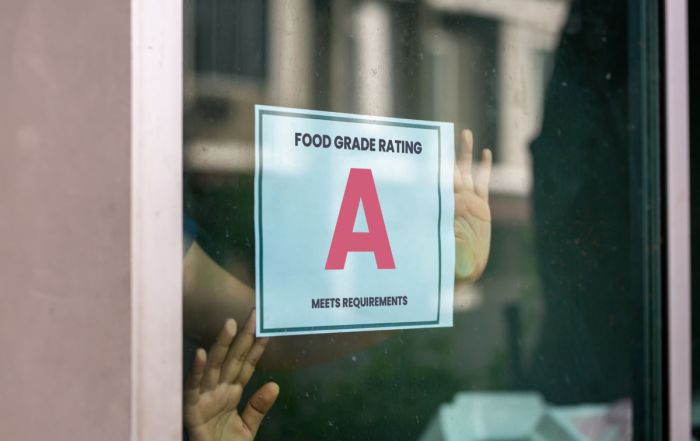Food Poisoning: Responding to a Complaint
In our first blog we covered background on investigations of foodborne illnesses. The SafeBites webinar on October 21st will discuss the process more thoroughly. If you haven’t already registered, registration is still open! In this blog, we offer some suggestions on responding to a direct complaint from a customer who thinks they got sick from eating at your foodservice. Responding to anonymous postings on social media is a whole other subject!
Long before you ever receive that call or email from a guest who thinks the food they consumed at your operation made them sick, obtain or prepare an intake form to guide the conversation with the customer. Most health inspectors or restaurant associations have a form that foodservice managers can use to collect information. Ideally, a designated staff member is charged with this responsibility to ensure continuity with those involved in the incident, as well as consistent actions and messages. It is helpful if this person has a good working relationship with the health inspector, as some of the information taken may be useful in an investigation of widespread outbreaks.
Long before you ever receive that call or email from a guest who thinks the food they consumed at your operation made them sick, obtain or prepare an intake form to guide the conversation with the customer.
Recognize the person calling may be upset, so stay calm and request the information that will help pin point the potential problem. Ask them their name and contact information; when they ate at the location (date and time); what they ate and drank; number in their party; what food they suspect caused their illness; symptoms experienced and duration; medical treatment obtained; and name of healthcare provider. If they are still experiencing symptoms, tell them to obtain a stool sample.
Thank them for the contact and promise to investigate. Then do so and follow up after the investigation is completed! Check with staff working the day of the reported incident to see if any were feeling ill. Check storage and production records to ensure there was no temperature abuse of any food. If possible, isolate the suspected food item. Check purchasing records to determine source of the food. If there are multiple calls with similar symptoms and circumstances, contact the local health inspector. It is much better to work with them as an ally, rather than them coming in as your adversary. In many cases, the health department can get a head start on testing samples if you are working closely with them to mitigate the problem and ensure public health. The operation’s legal consultant and insurance agent should also be informed of the situation.
Having the records available assists the management team in demonstrating that reasonable care was taken through the flow of food within the operation to control for any risks. The “paper trail” documents that reasonable care actions were communicated to staff (through SOPs and other written procedures) and were taken, as evidenced by cooking and storage logs. Without such documentation, reconstruction of what actually occurred gets blurry. An organization with written documentation has a good foundation because expectations are identified and clearly communicated.
Following the internal investigation, should it be found that this was an isolated incident that happened weeks ago and the individual calling did not seek medical treatment, the operation might still wish to provide some type of complimentary service as a token of the customer’s loyalty, without admitting to any wrong doing. All actions taken should be noted on the complaint form and kept with other records. Risk nothing!
READ MORE POSTS
Embracing Technology for Enhanced Food Safety in Foodservice Operations
Technology. We love it, we hate it. I’ve always been fascinated by technology; I remember getting my first Blackberry in the mid-90s and thinking it was the pinnacle of technological advances. Before that, I remember ordering a dictation program in college that was going to revolutionize the way I “typed” my assignments. Looking back, it really wasn’t worth the box that the program came in. Now, we have ChatGPT that will write the entire paper for us!
Meat Color and Doneness: Persistent Pinking
Late in June, my family and I were able to visit the Black Hills, an area of the country in which I have not had the opportunity to spend much time. One evening, as we dined at a local restaurant, I observed a table across the dining room sending back a dinner. While I couldn’t hear the entire conversation and I certainly wasn’t trying to eavesdrop, it was apparent that the customer was unhappy with the cooking of their hamburger and was sending it back because it was too pink in the middle. That immediately brought to my mind the phenomenon known as persistent pinking. A term I became familiar with because of work done by some colleagues here at Kansas State, which they present each summer to a group of foodservice operators who join us on-campus for an in-depth week-long look at all things food safety.
Quat Binding – Why this Can Have a Disastrous Impact on Your Sanitation Program.
In June, I had the opportunity to represent FoodHandler and speak on food safety behavior for customers of Martin Bros. Distributing in Waterloo, Iowa. One of the questions that was asked caught me a little off guard. The question was about quat binding. It caught me off guard not because it was a bad question, but only because it was not something I had previously been asked nor had not yet been exposed to the phenomenon. However, I soon learned that in certain jurisdictions, it is resulting in changes to how sanitizing cloths are to be stored in sanitizing buckets (or not) in the foodservice industry. When I returned home from the trip, I had to dig into it to learn about what quat binding is and how it might impact foodservice operations.
Are Grades for Foodservice Inspections a Good Idea?
I generally try to stay away from controversial topics in my blog, but this is one I thought it might be interesting to discuss. Occasionally on my travels, I will come across a state or a local jurisdiction that requires foodservice inspection scores be posted in the window of the establishment. The idea is to allow would-be customers the ability to see how the foodservice operation in which they are about to eat scored on their latest health inspection.










